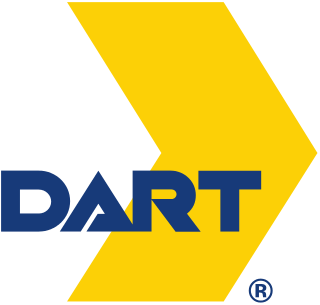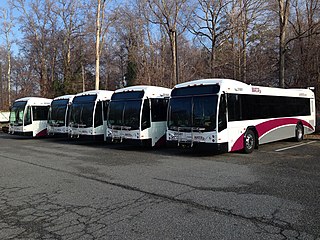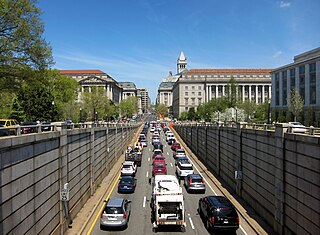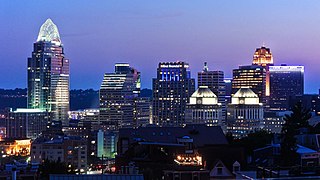
Dallas Area Rapid Transit (DART) is a transit agency serving the Dallas–Fort Worth metroplex of Texas. It operates buses, light rail, commuter rail, and high-occupancy vehicle lanes in Dallas and twelve of its suburbs. In 2022, the system had a ridership of 42,499,600, or about 161,700 per weekday as of the third quarter of 2023.

King County Metro, officially the King County Metro Transit Department and often shortened to Metro, is the public transit authority of King County, Washington, which includes the city of Seattle. It is the eighth-largest transit bus agency in the United States. In 2022, the system had a ridership of 66,022,200, or about 244,500 per weekday as of the third quarter of 2023. Metro employs 2,444 full-time and part-time operators and operates 1,540 buses.

Spokane Transit Authority, more commonly Spokane Transit or STA, is the public transport authority of central Spokane County, Washington, United States, serving Spokane, Washington, and its surrounding urban areas. In 2022, the system had a ridership of 6,995,300, or about 29,200 per weekday as of the third quarter of 2023.

Transportation in Philadelphia involves the various modes of transport within the city and its required infrastructure. In addition to facilitating intracity travel, Philadelphia's transportation system connects Philadelphia to towns of its metropolitan area and surrounding areas within the Northeast megalopolis.
The Greater Dayton Regional Transit Authority, formerly known as the Miami Valley RTA, is a public transit agency that generally serves the greater Dayton, Ohio area. The GDRTA serves communities within Montgomery County and parts of Greene County, Ohio, USA. There are 18 routes. RTA operates diesel and electric trolley buses seven days a week, 21 hours a day, and provides services to many citizens within the area. RTA's current CEO is Bob Ruzinsky. In 2022, the system had a ridership of 5,656,600, or about 20,400 per weekday as of the third quarter of 2023.

A tourist trolley, also called a road trolley, is a rubber-tired bus designed to resemble an old-style streetcar or tram, usually with false clerestory roof. The vehicles are usually fueled by diesel, or sometimes compressed natural gas.

The Interurban Transit Partnership, branded as The Rapid, is the public transit operator serving Grand Rapids, Michigan and its suburbs. In 2022, the system had a ridership of 5,106,600, or about 19,800 per weekday.

The Southern California Rapid Transit District was a public transportation agency established in 1964 to serve the Greater Los Angeles area. It was the successor to the original Los Angeles Metropolitan Transit Authority (MTA). California State Senator Thomas M. Rees sponsored the bill that created the RTD, which was meant to correct some deficiencies of the LAMTA, and took over all of the bus service operated by MTA on November 5, 1964. RTD was merged into the Los Angeles County Metropolitan Transportation Authority in 1993.

The Charleston Area Regional Transportation Authority (CARTA) provides area residents and visitors public transportation within parts of Charleston and Dorchester counties in the Lowcountry region of South Carolina, including the cities of Charleston, North Charleston and the surrounding communities of Mount Pleasant, Summerville, James Island, Sullivan's Island, and the Isle of Palms. CARTA presently contracts with Transdev for staffing and managing the bus drivers in addition to maintaining and scheduling the buses. In 2022, the system had a ridership of 2,191,500, or about 7,100 per weekday as of the third quarter of 2023.

CUE Bus (City-University-Energysaver) is a bus service operated by the City of Fairfax, Virginia, and is completely separate from the Fairfax Connector bus service run by Fairfax County. In 2022, the system had a ridership of 579,500, or about 3,500 per weekday as of the third quarter of 2023.

Transportation in Richmond, Virginia and its immediate surroundings include land, sea and air modes. This article includes the independent city and portions of the contiguous counties of Henrico and Chesterfield. While almost all of Henrico County would be considered part of the Richmond area, southern and eastern portions of Chesterfield adjoin the three smaller independent cities of Petersburg, Hopewell, and Colonial Heights, collectively commonly called the Tri-Cities area. A largely rural section of southwestern Chesterfield may be considered not a portion of either suburban area.

Metrobus is a bus service operated by the Washington Metropolitan Area Transit Authority (WMATA). Its fleet consists of 1,595 buses covering an area of 1,500 square miles (3,900 km2) in Washington, D.C., Maryland, and Virginia. There are 269 bus routes serving 11,129 stops, including 2,554 bus shelters. In 2022, the system had a ridership of 90,123,200, or about 355,800 per weekday as of the third quarter of 2023.

METRO Regional Transit Authority, also known as Akron Metropolitan Regional Transit Authority, is the public transit agency serving Summit County, Ohio and the city of Akron. It operates a number of local routes, and also operates one route into downtown Cleveland. Akron Metro transports passengers to/from school, work, grocery stores, malls and jobs all across Summit County. METRO RTA's fleet consists of about 200+ vehicles running on diesel, diesel-electric hybrid and as of 2022/2023, two fully electric Gillig vehicles, compressed natural gas fuels. In 2022, the system had a ridership of 3,673,700, or about 14,400 per weekday as of the third quarter of 2023.

Williamsburg Area Transit Authority (WATA) is a multi-jurisdiction transportation agency providing transit bus and ADA Paratransit services in the City of Williamsburg, James City County, York County in the Historic Triangle area and Surry County, VA of the Virginia Peninsula subregion of Hampton Roads in southeastern Virginia.

Washington, D.C. has a number of different modes of transportation available for use. Commuters have a major influence on travel patterns, with only 28% of people employed in Washington, D.C. commuting from within the city, whereas 33.5% commute from the nearby Maryland suburbs, 22.7% from Northern Virginia, and the rest from Washington, D.C.'s outlying suburbs.
Transportation in Florida includes a variety of options, including Interstate Highways, U.S. Highways, and Florida State Roads; Amtrak and commuter rail services; airports, public transportation, and sea ports, in a number of the state's counties and regions.

The Yuma County Area Transit (YCAT) system is a public transportation system based in Yuma County, Arizona. Since 1990 the agency has grown from a new transit service offering paratransit to the current mix of fixed-route and demand-responsive services serving over 32,000 riders per month, with an annual operating budget of $2.5 million. YCAT is also the local Greyhound Lines agent.

The Tri-State Transit Authority (TTA) is the city bus system in Huntington, West Virginia, and Ironton, Ohio, as well as its suburbs. Its buses range, on the West Virginia side from 21st Street in Kenova, WV to Milton, West Virginia, about 20 miles to the east. On the Ohio side the buses range from downtown Ironton to the Huntington suburb of Proctorville, Ohio, which is also a range of about 20 miles. Interchange buses provide links between Huntington and Chesapeake, Ohio, and between Ironton and Ashland, Kentucky, where transfers are available to the Ashland Bus System (ABS). However the system does not interchange between the TTA and ABS in Ceredo, West Virginia, even though the buses pass within a few blocks of one another.
Atlanta's transportation system is a complex infrastructure of several systems, including 47.6 miles of heavy rail, 91 bus transit routes, 1,600 licensed taxis, a comprehensive network of freeways, the world's busiest airport and over 45 miles of bike paths.

Transportation in Cincinnati includes sidewalks, roads, public transit, bicycle paths, and regional and international airports. Most trips are made by car, with transit and bicycles having a relatively low share of total trips; in a region of just over 2 million people, less than 80,000 trips are made with transit on an average day. The city is sliced by three major interstate highways, I-71, I-74 and I-75, and circled by a beltway several miles out from the city limits. The region is served by two separate transit systems, one on each side of the river. SORTA, on the Ohio side is about six times larger than TANK on the Kentucky side.


















